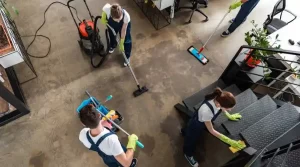Consider how much time you spend with your electronic devices, including anything from computers, keyboards, mouse, copiers, and printers, to phones and headsets. We utilize them often in both our personal and business lives.
Disinfecting electronic equipment is more vital than ever, particularly given the tremendous effect of COVID-19. From the specialists at Joliet Commercial Cleaners, you’ll discover all you need to know about safely and successfully cleaning and sanitizing electronic equipment in this thorough handbook.
What are the benefits of cleaning and disinfecting electronic equipment?
Germs and bacteria thrive in electronic devices. Indeed, studies have shown that keyboards, mouse, and other workplace equipment may be up to ten times more filthy than a toilet seat! It’s no surprise that so many people become sick each year from avoidable diseases like the cold and flu, given how much time we spend using electronic devices. Cleaning is particularly critical in light of the epidemic. (1)
Cleaning and disinfecting electronic equipment are crucial for two reasons: preventing the transmission of germs that cause sickness and protecting the device from harm. Over time, dust, filth, and grime may accumulate on electrical equipment, leading it to malfunction or fail. Extend the life of your electronic equipment and keep it running correctly by cleaning and disinfecting it regularly.
What chemicals are safe for electronics?
Many cleansers and disinfectants claim to be safe for electronics. They are not. However, all are created equal. Because certain cleaners may potentially harm electronic equipment, so it’s critical to choose one mainly intended for cleaning it.
Isopropyl alcohol, usually known as rubbing alcohol, is a popular and efficient disinfectant for electronic devices.
(2) This disinfectant is safe on most electronic devices and is very efficient in killing germs and bacteria. To achieve the most outstanding results, use an isopropyl alcohol disinfectant that contains at least 70% alcohol.
Hydrogen peroxide is another safe and efficient disinfectant for electronics. Because it is so powerful at destroying germs and bacteria, this disinfectant is often used in hospitals and other medical environments. To obtain the most outstanding results, use a hydrogen peroxide disinfectant with a concentration of at least 3%.
Procedures to follow before cleaning and sanitizing electronic devices
- First, thoroughly wash your hands with soap and water to eliminate dirt or bacteria.
- Disconnect any electrical devices. Always detach a computer from the computer and turn it off before cleaning a keyboard, mouse, or computer.
- Electronic equipment should be devoid of any batteries. It is crucial to remove batteries before washing since cleaning agents may harm them.
- Gather all required supplies, including gloves, microfiber cloths, and disinfectant wipes or spray.
- Ascertain that the location in which you are operating is well-ventilated.
- Take the electrical equipment outdoors, if feasible. This will prevent any toxic chemicals or gases from harming the equipment.
- Any electrical components or circuits that are exposed should be taped. They will remain secure as a result while you clean and sanitize them.
How to clean and disinfect computer monitors, keyboards and mice
Disinfecting monitor:
- Use a disinfectant wipe to clean the monitor or a microfiber cloth sprayed with an antiseptic to clean the screen. Avoid getting any cleaner on the bezel (the frame around the screen).
- Make use of a clean, dry microfiber cloth to wipe away any cleaner that may have contacted the bezel.
- Polish the screen using glass cleaner and a fresh, dry microfiber cloth.
- Cleaning the keyboard:
To remove any stray dirt or debris, shake the keyboard.
- Use a microfiber cloth and a disinfectant wipe or spray to clean the keys. Be cautious while inserting your fingers between the keys.
- A dry microfiber cloth may wipe away any cleaner that might have gotten on the keys.
- With a dry microfiber towel and glass cleaner, polish the keys.
- Only seldom is it a good idea to take the keys out. However, taking the keys out is easy if it’s safe and you want to go the extra mile. Shake the keyboard by flipping it over. Before removing the keys using a flathead screwdriver or similar instrument, thoroughly clean off any dirt or debris, disinfect them with a disinfectant wipe or spray, and let them air dry.
Disinfecting mouse:
- Wipe off the mouse’s top with a disinfectant wipe or spray a disinfectant into a microfiber cloth and wipe it down.
- Clean any dirt or debris between the buttons using a cotton swab or toothpick.
- Remove any with a clean, dry microfiber cloth. Cleaning that has gotten on the mouse.
- Polishing the mouse using a glass cleaner and a clean, dry microfiber towel.
How to clean and disinfect copiers and printers
Disinfecting copier:
- Unplug the copier from the power source and turn it off.
- Clear the copier of any paper.
- Open all of the copier’s doors and compartments to access all surfaces that need cleaning.
- Wipe all surfaces clean with a disinfectant wipe or spray a disinfectant into a microfiber cloth and wipe it off. Clean the control panel, touch screen, buttons, and any other surfaces you encounter.
- Clean any dirt or debris between the keys or buttons using a cotton swab or toothpick.
- Clean up any with a dry, clean microfiber cloth. Cleaner that has gotten on the copier.
- All surfaces should be polished with glass cleaner and a clean, dry microfiber cloth.
- Restart the copier and reconnect it to the power source.
Disinfecting printer:
- Please turn off the printer and unhook it from the wall.
- Take out all of the paper from the printer.
- To reach all the surfaces that need to be cleaned, open all the printer’s doors and compartments.
- Wipe all surfaces clean with a disinfectant wipe or spray a disinfectant into a microfiber cloth and wipe it off. Clean the control panel, touch screen, buttons, and any other surfaces you encounter.
- Clean any dirt or debris between the keys or buttons using a cotton swab or toothpick.
- Remove any cleaner that may have gotten on the printer with a clean, dry microfiber cloth.
- All surfaces should be polished with glass cleaner and a clean, dry microfiber cloth.
- Restart the printer and reconnect it to the power outlet.
How to clean and disinfect phones and headsets
Disinfecting phones:
- Switch off the phone.
- Remove the battery and SIM card (if applicable).
- Wipe all surfaces clean with a disinfectant wipe or spray a disinfectant into a microfiber cloth and wipe it off. Make care to wipe the screen, buttons, and any other surfaces with which you come into touch.
- Clean any dirt or debris between the keys or buttons using a cotton swab or toothpick.
- Remove any cleanser that has gotten on the phone using a clean, dry microfiber cloth.
- All surfaces should be polished with glass cleaner and a clean, dry microfiber cloth.
- Reinstall the battery (if feasible) and power on the phone.
Disinfecting headsets:
- Turn off your phone.
- Remove the SIM card and batteries (if applicable).
- Wipe all surfaces clean with a disinfectant wipe or spray a disinfectant into a microfiber cloth and wipe it off. Make care to wipe the screen, buttons, and any other surfaces with which you come into touch.
- Clean any dirt or debris between the keys or buttons using a cotton swab or toothpick.
- Remove any cleanser that has gotten on the phone using a clean, dry microfiber cloth.
- Polishing all surfaces with glass cleaner and a dry, clean microfiber cloth.
- Reinstall the battery, then turn the phone on.
How to clean and disinfect a laptop
Disinfecting the exterior:
- Wipe the monitor down with a disinfectant wipe, or spray a disinfectant into a microfiber cloth and wipe the screen down. Take care not to get any cleaner on the bezel (the frame around the screen).
- Clean the keyboard with a microfiber cloth and a disinfectant wipe or spray. Take caution while slipping your fingers between the keys.
- Use a disinfectant wipe to clean the touchpad, or spray a disinfectant into a microfiber cloth and wipe it down.
- Remove any cleaner from the display, keyboard, or touchpad using a clean, dry microfiber cloth.
- Polish the screen using glass cleaner and a fresh, dry microfiber cloth.
- With a dry microfiber cloth and glass cleaner, polish the keyboard.
Cleaning the interior:
- Blow any dust or debris from the gaps between the keys using compressed air.
- Wipe down the keyboard with a disinfectant wipe or a disinfectant sprayed onto a microfiber cloth. Make sure you get between the keys.
- Wipe down the touchpad with a disinfectant wipe or spray it with disinfectant and wipe it down.
- Clean any dirt or debris between the buttons using a cotton swab or toothpick.
- Remove any cleaner that has gotten on the keyboard or touchpad using a clean, dry microfiber cloth.
- Use a glass cleaner and a dry microfiber towel to polish the keyboard.
Is UV light effective for disinfecting electronic equipment?
UV light disinfection is a widely used approach for cleaning electronic equipment. There is, however, no scientific proof that UV light disinfection kills germs and bacteria. Several studies have shown that UV radiation may harm electrical devices. (3)
If you decide to employ UV light disinfection, do it correctly. To begin, disconnect the device from all power sources. Place the UV light at least six inches away from the device. Please turn on the UV light and wait at least two minutes for it to disinfect the equipment. After disinfection, ensure the equipment is dry before using or storing it.
How not to clean and disinfect electronic equipment
When cleaning and sanitizing electronic equipment, you should avoid a few things.
- Use no cleaners or disinfectants that are not mainly developed for cleaning electronic equipment. These cleaners may harm the equipment.
- Submerge electrical devices in no liquids. This may damage the electronics and nullify any warranties.
- Use UV light disinfection on any electronic equipment with sensitive surfaces, such as LCDs. UV rays may cause harm to these surfaces.
- Avoid using strong chemicals, such as bleach, on electrical equipment. These substances may harm electronics.
- Do not use compressed air to clean electrical equipment. The pressurized air might drive dirt and dust into the apparatus, causing it to fail.
How often should electronic equipment be disinfected?
It’s critical to disinfect electronic equipment regularly, particularly if it’s shared. However, you should disinfect electronic equipment more often if it is used in a hospital environment or if it has been used by someone unwell.
If someone who uses the equipment becomes unwell, disinfect it as quickly as feasible. It should also be disinfected if the kit touches body fluids, such as blood or saliva.
What are the benefits of regularly cleaning and disinfecting electronic equipment?
Regularly cleaning and sanitizing electronic equipment may aid in the prevention of disease in the workplace. Employee sick days might be reduced by cleaning the equipment. This, in turn, has the potential to boost workplace productivity and morale.
It also helps to increase the life of your electrical devices. You can avoid the accumulation of dirt and dust on the equipment by disinfecting it regularly. Follow these guidelines to thoroughly clean and disinfect your electronic equipment.
Do you need Professional Help?
Joliet Commercial Cleaners. Cleans commercial premises and the most sensitive regions and equipment inside them. Employee and consumer safety is more vital than ever, and disinfection should be prioritized. Remove the burden of handling it yourself or questioning if your company is clean. Contact Joliet Commercial Cleaners Cleaning at 610 Moen Ave 310 Joliet, IL, for personalized service plans.







